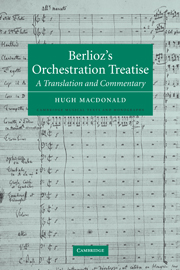Book contents
- Frontmatter
- Contents
- List of illustrations
- Preface
- A note on the edition
- A note on the translation
- Acknowledgments
- List of abbreviations
- The Treatise
- Introduction
- 1 Bowed strings
- 2 Plucked strings
- 3 Strings with keyboard
- 4 Wind: Introduction
- 5 Wind with reeds
- 6 Wind without reeds
- 7 Wind with keyboard
- 8 Brass with mouthpiece
- 9 Woodwind with mouthpiece
- 10 Voices
- 11 Pitched percussion
- 12 Unpitched percussion
- 13 New instruments
- 14 The orchestra
- 15 The conductor and his art
- Appendix: Berlioz's writings on instruments
- Bibliography
- General index
- Index of Berlioz's works
1 - Bowed strings
Published online by Cambridge University Press: 22 September 2009
- Frontmatter
- Contents
- List of illustrations
- Preface
- A note on the edition
- A note on the translation
- Acknowledgments
- List of abbreviations
- The Treatise
- Introduction
- 1 Bowed strings
- 2 Plucked strings
- 3 Strings with keyboard
- 4 Wind: Introduction
- 5 Wind with reeds
- 6 Wind without reeds
- 7 Wind with keyboard
- 8 Brass with mouthpiece
- 9 Woodwind with mouthpiece
- 10 Voices
- 11 Pitched percussion
- 12 Unpitched percussion
- 13 New instruments
- 14 The orchestra
- 15 The conductor and his art
- Appendix: Berlioz's writings on instruments
- Bibliography
- General index
- Index of Berlioz's works
Summary
THE VIOLIN
The four strings of the violin are normally tuned in fifths, with the fourth string tuned to g, the third to d′, the second to a′ and the first to e″. The top string, the e″ string, is also known as the ‘chanterelle’. When the left-hand fingers are not modifying the pitch by shortening the portion of string set in motion by the bow, the strings are termed ‘open’ strings. Notes to be played open are indicated by an ‘o’ marked above them.
Certain great players and composers have not felt under any obligation to tune the violin in this way. Paganini tuned all the strings a semitone higher, to a♭, e♭′, b♭′ and ƒ″, to give the instrument more brilliance. So by transposing the solo part he would be playing in D when the orchestra was in E♭, or in A when they were in B♭, thus keeping most of the strings open with their greater sonority without having to apply the fingers. This would not have been possible with normal tuning. De Bériot often tunes the g string up a tone in his concertos; Baillot, on the other hand, used to tune the g string down a semitone for soft, low effects. Winter even used ƒ instead of g for the same purpose.
Paganini's Violin Concerto in E♭, op. 6, was intended to be played on a violin tuned up a semitone; the soloist is thus playing in D (Mozart used the same scordatura for the viola in his Sinfonia concertante, K. 364). This scordatura is also found in Paganini's variations on ‘Di tanti palpiti’ from Rossini's Tancredi. […]
- Type
- Chapter
- Information
- Berlioz's Orchestration TreatiseA Translation and Commentary, pp. 7 - 63Publisher: Cambridge University PressPrint publication year: 2002

